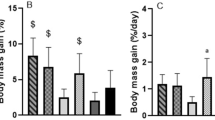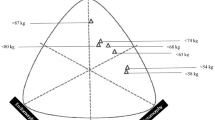Abstract
Purpose
The rationale of our study derived from the important changes in judo rules, with particular consideration of the leg grabs. Therefore, the present study aimed at demonstrating the relationships between stature and successful matches in elite judo, in relation to both genders and seven weight categories.
Methods
Stature levels and final ranking position of each participant were recorded on the base of the year of Olympic Game (Athens 2004, Beijing 2008, London 2012, Rio 2016), gender, and weight class. A one-way ANCOVA was applied to determinate possible differences (p ≤ 0.05) among judoka’s statures related to each Olympic Game.
Results
Results showed that no difference has been reported for stature level of each judo Olympic Game in all and only male judoka. On the contrary, for female, difference (p = 0.007) on judoka’s stature levels among ranking positions generally emerged, reporting increases in stature levels between the first and the fifth (from 163.62 ± 7.95 to 167.90 ± 8.88 cm; p = 0.004), and the seventh (from 163.62 ± 7.95 to 168.26 ± 8.53 cm; p = 0.016) ranking position.
Conclusion
Considering that no relationship between stature and successful matches in elite judo emerged in the analyzed four Olympics Games, it can speculate that no advantage can be attributed to the taller judoka’s for the rule changes regarding the leg grabs.


Similar content being viewed by others
References
Kano J (1994) Kodokan judo: the essential guide to judo by its founder Jigoro Kano. Kodansha International, Tokyo
International Judo Federation (2017) Sports and organization rules of the international judo federation. https://www.ijf.org/ijf/documents/2. Accessed 27 Sept 2017
Sato S (2013) The sportification of judo: global convergence and evolution. Glob J Health Sci 8(02):299–317. https://doi.org/10.1017/s1740022813000235
Marcon G, Franchini E, Jardim JR, Barros Neto TL (2010) Structural analysis of action and time in sports: judo. J Quant Anal Sports 6(4):1–15. https://doi.org/10.2202/1559-0410.1226
Sbriccoli P, Bazzucchi I, Di Mario A, Marzattinocci G, Felici F (2007) Assessment of maximal cardiorespiratory performance and muscle power in the Italian Olympic judoka. J Strength Cond Res 21(3):738–744. https://doi.org/10.1519/r-20245.1
Franchini E, Sterkowicz S, Meira CM Jr, Gomes FRF, Tani G (2008) Technical variation in a sample of high level judo players. Percept Mot Skills 106(3):859–869. https://doi.org/10.2466/pms.106.3.859-869
Calmet M, Ahmaidi S (2004) Survey of advantages obtained by judoka in competition by level of practice. Percept Mot Skills 99(1):284–290. https://doi.org/10.2466/pms.99.1.284-290
Han L (2015) Judo writing. The evolution of the no-leg-grab rules at IJF Judo competition from 2010 to present. http://www.judolink.club/2010-2016-IJF-no-leg-grab-rules.html. Accessed 11 Oct 2016
Giatsis G, Tili M, Zetou E (2011) The height of the women’s winners FIVB Beach Volleyball in relation to specialization and court dimensions. JHSE 6(3):497–503. https://doi.org/10.4100/jhse.2011.63.03
Ma S-M, Liu C-C, Tan Y, Ma S-C (2013) Winning matches in Grand Slam men’s singles: an analysis of player performance-related variables from 1991 to 2008. J Sports Sci 31(11):1147–1155. https://doi.org/10.1080/02640414.2013.775472
Tucker R, Collins M (2012) What makes champions? A review of the relative contribution of genes and training to sporting success. Br J Sports Med 46:555–561. https://doi.org/10.1136/bjsports-2011-090548
Franchini E, Takito MY, Calmet M (2013) European Judo Championships: impact of the new rule changes on points and penalties. Int J Perform Anal Sport 13(2):474–479. https://doi.org/10.1515/humo-2015-0012
Miarka B, Julio UF, Del Vecchio FB, Calmet M, Franchini E (2010) Técnica y táctica en judo: una revisión. RAMA 5(1):91–112. https://doi.org/10.18002/rama.v5i1.139
Dopsaj M, Todorov I, Vuković M, Radovanović D (2013) Various morphological indicators in elite judo athletes defined by multi-frequency bioelectrical impedance analysis. Serb J Sports Sci 7(3):129–141
Sterkowicz S, Sacripanti A, Sterkowicz_Przybycien K (2013) Techniques frequently used during London Olympic judo tournaments: a biomechanical approach. Arch Budo Sci 9:51–58. https://doi.org/10.12659/aob.883848
Lech G, Sterkowicz S, Rukasz W (2007) Significance of body height in martial arts (as exemplified by judo fighters). Hum Mov Sci 15:21–26
Casolino E, Cortis C, Lupo C, Chiodo S, Minganti C, Capranica L (2012) Physiological versus psychological evaluation in taekwondo elite athletes. Int J Sports Physiol Perform 7(4):322–331. https://doi.org/10.1123/ijspp.7.4.322
Lupo C, Capranica L, Tessitore A (2014) The validity of session-RPE method for quantifying training load in water polo. Int J Sports Physiol Perform 9(4):656–660. https://doi.org/10.1123/ijspp.2013-0297
Lupo C, Capranica L, Cortis C, Guidotti F, Bianco A, Tessitore A (2017) Session-RPE for quantifying load of different youth taekwondo training sessions. J Sports Med Phys Fitness 57(3):189–194. https://doi.org/10.5114/biolsport.2017.63381
Chiodo S, Tessitore A, Lupo C, Ammendolia A, Cortis C, Capranica L (2012) Effects of official youth taekwondo competitions on jump and strength performance. Eur J Sport Sci 12(2):113–120. https://doi.org/10.1080/17461391.2010.545837
Invernizzi PL, Longo S, Bizzi M, Benedini S, Merati G, Bosio A (2015) Interpretation and perception of two different kumite fighting intensities through an integrated approach training in international level Karatekas: an exploratory study. Percept Mot Skills 121(2):333–349. https://doi.org/10.2466/30.06.PMS.121c19x4
Miarka B, Brito CJ, Dal Bello F, Amtmann J (2017) Motor actions and spatiotemporal changes by weight divisions of mixed martial arts: applications for training. Hum Mov Sci 55:73–80. https://doi.org/10.1016/j.humov.2017.07.009
Author information
Authors and Affiliations
Corresponding author
Ethics declarations
Conflict of interest
The authors declare no conflict of interest.
Ethical approval
The study was approved by the Ethical Committee of the University of Torino (Turin, Italy; prot. 26831) and performed in accordance with the Helsinki Declaration.
Informed consent
No informed consent was obtained due to the nature of the study.
Rights and permissions
About this article
Cite this article
Brustio, P.R., Boccia, G., Moisè, P. et al. Relationship between stature level and success in elite judo: an analysis on four consecutive Olympic Games. Sport Sci Health 14, 115–119 (2018). https://doi.org/10.1007/s11332-017-0411-4
Received:
Accepted:
Published:
Issue Date:
DOI: https://doi.org/10.1007/s11332-017-0411-4




